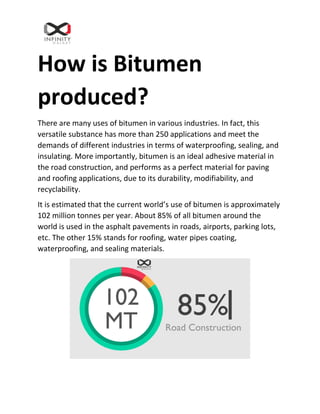
How is bitumen produced?
- 1. How is Bitumen produced? There are many uses of bitumen in various industries. In fact, this versatile substance has more than 250 applications and meet the demands of different industries in terms of waterproofing, sealing, and insulating. More importantly, bitumen is an ideal adhesive material in the road construction, and performs as a perfect material for paving and roofing applications, due to its durability, modifiability, and recyclability. It is estimated that the current world’s use of bitumen is approximately 102 million tonnes per year. About 85% of all bitumen around the world is used in the asphalt pavements in roads, airports, parking lots, etc. The other 15% stands for roofing, water pipes coating, waterproofing, and sealing materials.
- 2. However, few people know how bitumen is produced. Bitumen is produced by the distillation of crude oil, or simply found in nature. Based on the source, bitumen’s physical properties such as consistency, stiffness, viscosity, adhesion, and durability may differ. Therefore, it is crucial to becoming more familiar with bitumen’s occurrence in nature and bitumen as a byproduct of crude oil. You can find the link to our newest video about bitumen production at the end of this document. What is Bitumen? Bitumen is an adhesive material composed of complex hydrocarbons. This high viscose material contains elements such as calcium, iron, sulfur, and oxygen. Bitumen has a remarkable ability to change with temperature variations. At lower temperatures, this material is rigid and brittle, at room temperature, it is flexible, and at higher temperatures bitumen flows. Bitumen was first used for adhering woods to stone tools some 40,000 years ago (by Middle Paleolithic Neanderthals). Afterward, bitumen was used as an adhesive material in a wide variety of applications.
- 3. Bitumen has also a unique density and viscosity in comparison to other byproducts of crude oil. Due to the presence of large hydrocarbon molecules known as asphaltenes and resins, which are present in lighter oils but are highly concentrated in bitumen, bitumen has become useful material in binding stones and sands for road construction. How Bitumen is formed in the Nature? In order to understand how bitumen is formed in nature, we need to go back to more than 360 million years ago. Fossil fuels formed during the Carboniferous period, when giant swamp forests dominated many parts of the Earth. Many microscopic organisms lived, died, and decayed in these forests and formed the basis for the production of coal deposits. With the accumulation of sediment layers and their gradual transformation
- 4. under heat and pressure over many years, great bituminous coalfields created. These ancient deposits are now the source of natural bitumen in various countries, including Canada, Venezuela, and Oman. Known also as oil sands, the deposits are now a mixture of sand, clay, and water, saturated with a dense and extremely viscous bitumen. Although large natural reservoirs of bitumen exist in many parts of the world, most of the bitumen produced in the world is derived from crude oil. Natural bitumen extraction is more complicated than refining bitumen, therefore it will cost the producers more. It is also interesting to know that natural bitumen contains up to 5% sulfur, heavy metals, and other impurities that must be refined.
- 5. How Bitumen is manufactured in the Petroleum Industry? The process of separating bitumen from crude oil begins in the atmospheric distillation column, followed by a heating process in which the crude oil evaporates. The vapor flies cools and becomes liquid again. Distillation trays in the column will enhance the process of liquid separation according to the molecular weight. The heaviest part of the oil that remains at the bottom of the distillation column, is called Vacuum Bottom, and form the raw material for producing refined bitumen. Properties and quality of bitumen depend mainly on the crude oil used in its manufacturing process.
- 6. Bitumen can be further processed by blowing air through it at elevated temperatures. For this the Vacuum Bottom is transferred to the vacuum distillation column, to go through a blowing process. A mild degree of air-blowing is commonly used to make a minor adjustments to the physical properties of the vacuum bottom, such as decreasing the penetration of the bitumen. In this stage, various types of bitumen which have more asphaltene and molecular weight, with higher penetration value are produced. For various types of bitumen visit here. Production of Bitumen by refining crude oil is highly economical. In the distillation process of crude oil, which is essential for producing petrol, diesel, high octane fuels, and gasoline, bitumen is left behind and can be used easily after processing. Watch our video about natural and refined bitumen by clicking on the link below: https://infinitygalaxy.org/where-does-bitumen-come-from/